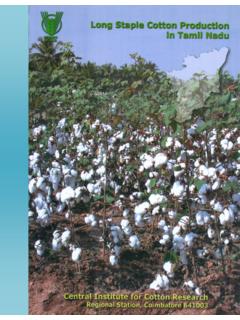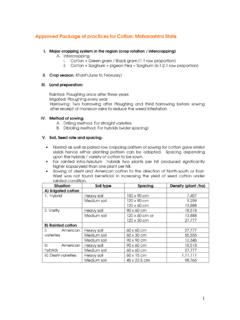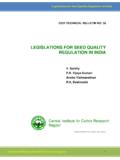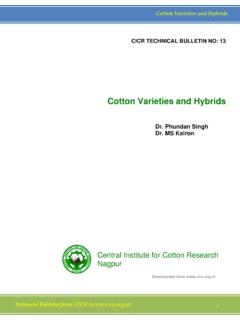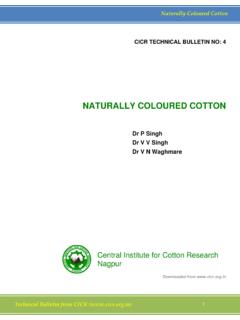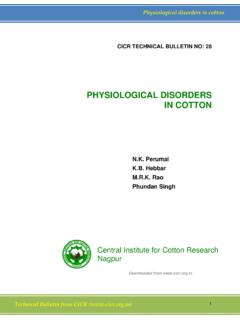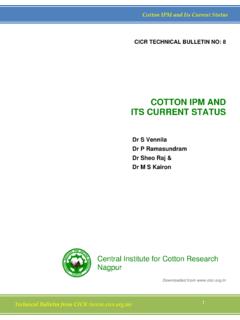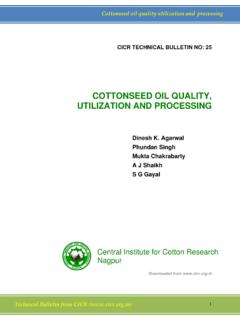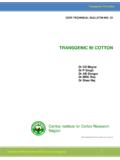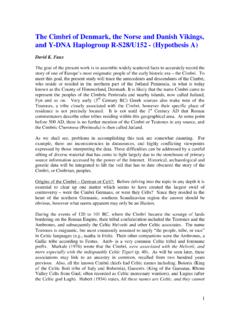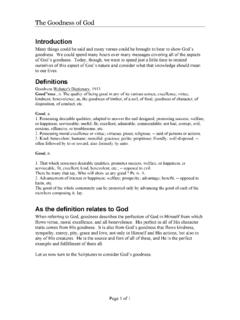Transcription of early History Of Cotton In India - Central Institute
1 1. Abstract The antiquity of Cotton in the Indian subcontinent has been traced to the 4th millennium BC. The fabrics dated approximately 3000 BC, recovered from the Mohenjo-daro excavations in Sind (Pakistan), were identified to have originated from Cotton plants, closely related to the Gossypium arboreum species. The lint-bearing species of the genus Gossypium, the true cottons, are four, out of which the diploid (2n = 26) species G. arboreum and G. herbaceum are indigenous in Asia and Africa. The History of introduction into India of the new world cottons (tetraploid species of G. hirsutum and G. barbadense with 2n =52) dates back to the 18th century AD. By the last decade of the 20th century. India had gained a pride of place in the global Cotton statistics with the largest cropped area of million in 1996-97, growing the most diverse cultivars in terms of botanical species and composition, producing the widest range of Cotton fiber quality suitable for spinning 6's to 120's counts yarn, and supporting the largest agro-based national industry of the country.
2 The article presents an overview of the ancient origins of the indigenous cottons of India , the recorded History of the crop from the early introductions to their rapid spread of cultivation in response to export and domestic needs during the pre-independence period (1900-47). And the spectacular advances in quantitative and qualitative composition, to support the requirements of the national textile industry after independence (1947-97). Introduction Animal skins and hides, and barks of some tree species were probably the earliest materials used by pre-historic human beings to cover their bodies. The earliest known woven fabrics were those used as shrouds for the Egyptian mummies. These shrouds are considered to be made around 5500 BC although some authorities claim these were older (12000-10000 BC) and made of linen.
3 It has to be recognized that cellulosic fibers in general and Cotton (Gossypium spp.) in particular are easily degraded by microorganisms and are not normally found in a preserved condition in archaeological excavations. Nevertheless, there is enough scientific evidence to trace that Cotton has been used in India for over 5000 years. Antiquity of Cotton in India In the past, ideas and details of events were passed on through generations orally rather than in writing. It is therefore difficult to pinpoint when the use of Cotton began in India . 2. Reference in ancient texts Although these is a reference to threads in looms in the Rigveda ascribed to have been variously complied between 4000 BC and 1200 BC, there is no specific mention of Cotton in this ancient sacred text.
4 However, in the Vedangas, , in Sutra literature ascribed to have been written around 1000 BC in the principal Apasthamba Grihya Sutra, Manthara Patha, Ekagni Khanda, Prasna 11, Adh 2 Riks 3 and 4, a reference to Cotton reads as follows, when translated from Sanskrit. O cloth! The Goddess Revati prepared a sliver by beating you out of seeds. The Goddess Krithika spun you into yarn. The Goddess Dhee did the weaving. The Goddess Gna cut and took you out of the loom. The above goddesses and thousands more made up the ends at both sides of the cloth. The Goddesses gave the cloth to the Sun (Savitr). God and even as he put it on, its greatness became explicit. So, too, is the cloth.. It may be noted that the stages of ginning of seed Cotton , spinning the lint and weaving the yarn are covered in the religious text, thus suggesting the implicit use of Cotton in India by 1000 BC (Sundaram, 1974).
5 In the days of Herodotus, the father of History , who wrote around 445 BC, it was evident that Indians wore Cotton clothes. He wrote that they possess a kind of plant which instead of fruit, produces wool of a finer and better quality than that of sheep; of this the Indians make their clothes . In Manu Smriti, ascribed to have been written around the second century BC (Ramanatha Ayyar and Parameswara Aithal, 1964) verse 44, chapter 2, reads as follows when translated from Sanskrit. The sacred thread of Brahman shall be of Cotton , of right-twisted three ply; of a Kshatriya (shall be) of hemp and of a Vaisya (shall be) of wool . The other sacred texts such as Ramayana, Mahabharata, and the Puranas also contain references to Cotton materials, apart from the Tamil Sangam (Academy) literature dated prior to third century AD (Ramanatha Ayyar, 1962).
6 The use of Cotton seed as food during famine, untwisted lint as wick for lamps, and the evolution of the lint as material for spinning and its use as textiles have been mentioned in the ancient Dravidian literature. Use of Cotton in ancient India The speculations about the earliest use of fibres from Cotton in the Indian subcontinent were set at rest with the discovery of Cotton materials in the excavations at Mohenjodaro in the Indus Valley carried out during the 1920's (Gulati and Turner, 1929). The archaeological evidence showed that the Cotton samples retrieved from Mohenjodaro would have been made around 3000 BC. In these excavations, well-preserved fabrics of Cotton were discovered in silver vessels. The fragment of fabric was carefully examined at the Cotton Technological Research Laboratory, Bombay (now Central Institute for 3.)
7 Research on Cotton Technology, Mumbai). The photograph of the fabric and microphotograph of the fiber from the excavated sample are reproduced (Fig. 1), as recopied and enlarged from Bulletin No. 17 Technological series, October 1928. published by the Indian Central Cotton Committee, Technological Laboratory. After critical examination of the fiber's properties of length, weight per unit length, fiber strength, convolutions per inch, ribbon width, and fiber rigidity, Gulati and Turner (1929). concluded that on the whole, this early Cotton has been produced from Cotton plants closely related to the present day G. arboreum types. According to Hutchinson and Stephens (1947), the progenitors of the early cottons of the Indus Valley must have been introduced from southern Arabia or northeastern Africa.
8 Botanical status of true cottons The lint-bearing species of the genus Gossypium, the true cottons are four, out of which the diploid (2n = 26) species of G. arboreum L. and G. herbaceum L. are indigenous to Asia and Africa and are popularly referred to as desi cottons in India . The new world cottons, , the tetraploid (2n = 52) species of G. hirsutum L. and G. barbadense L. were initially introduced into India during the 17th and 18th centuries AD. It has been shown that the new world cottons are natural amphidiploids containing the A genome from a taxon of the Asiatic diploid group and a D genome from a taxon of the American diploid group. The new world cottons are popularly known as American (G. hirsutum) and Egyptian (G. barbadense) cottons. Origin of the indigenous cottons Santhanam and Hutchinson (1974) summarized the origins of indigenous cottons as follows: The Cotton textiles of the Harappan civilization (2300-1750 BC) were produced by sophisticated textile craftsmanship.
9 Thus at the earliest agricultural levels yet discovered, true cottons were already present in the Indian subcontinent. Wild and weedy types have been found to be associated with primitive cultivated types in both the old world species of G. herbaceum and G. arboreum. Species of G. herbaceum have been found from the coastal strip northwest of Karachi (Pakistan), through northern Baluchistan to south Yemen, Ethiopia, and Sudan and even in West Africa south of the Sahara. Species of G. arboreum, have been recorded by Watt (1907) in Kathiawar, Gujarat, Khandesh, and the Deccan in India . It seems likely that it was in Gujarat ( India ) or Sind (Pakistan) that G. arboreum cottons were first brought into cultivation (Hutchinson, 1971). It may further be surmised that the differentiation of the three perennial races of G.
10 Arboreum, namely burmanicum of northeastern India , indicum of western India and the Penninsula, and sudanense of northern Africa, ante-dated domestication and that each contributed separately to the cultivated cottons in Asia and Africa. 4. Evidence on the origin of the new world cottons is not presented in this paper which is primarily concerned with Asian agri-histroy of Cotton . It is sufficient of state however that G. barbadense and G. hirsutum existed as distinct species in the wild in Central America and their cultivated derivatives were separately domesticated. Cotton goods and its trade in India Pre-Christian era Consequent to the invasion of India by Alexandar the Great (327-323 BC), Greek merchants commenced the import of Cotton cloth from India .
